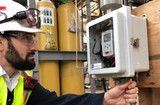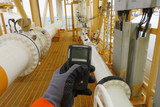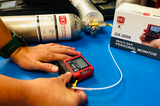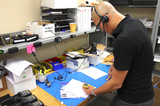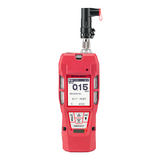Blog
Frequently Asked Questions about LEL Gas and LEL Gas Detectors
Understanding the lower explosive limits (LEL) of combustible gases is crucial when it comes to protecting the health and safety of your employees. As a construction worker, maintenance professional or someone that works in confined spaces, you need to be aware of the LELs of certain hazardous gases, while measuring the amount of gas in the air as a percentage of the total volume using a gas monitor. If the amount of gas in the air suprasses the LEL, the gas could spontaneously combust, injur
…
Apr 6th 2020
What You Need to Know When Purchasing Gas Monitors for Your Business
When most people think of gas detection, they probably picture petroleum production facilities. However, oil and gas workers aren’t the only ones that need to keep an eye on the air quality: putting on personal protective equipment like portable gas detectors is a part of the workday for sewage treatment plant workers, maintenance engineers, firefighters, and many other workers across a variety of industries. When you’re making a decision about which gas monitors are right for your workplace,
…
Jan 7th 2020
Calibration Gas Shelf Life: Do Calibration Gases Have a Shelf Life?
When using a gas monitor, it’s important to make sure your monitor is properly calibrated, otherwise your readings may be inaccurate. To properly calibrate your monitor, you’ll need to use a concentration of the gas you’re trying to detect. The test gas typically comes in disposable or nonrefillable cylinders that either made of steel or aluminum. This is also known as a calibration gas or span gas, but these gases have a shelf life. You’ll need to replace your calibration gases according to
…
Oct 14th 2019
PK Safety's In-house Calibration and Repair Services
Gas monitor calibration is a must if your
employees are working in a confined space or around dangerous gasses and
chemicals. The gas monitor is designed to alert you and your colleagues if gas readings reach unsafe levels, which could endanger you and the lives of your employees. But
these monitors are prone to errors. You need to calibrate your gas monitor on a
regular basis to make sure it’s working properly. Learn more about gas monitor
calibration and why it’s important for your facili
…
Apr 22nd 2019
Benzene Gas Detector: RKI Instruments New GX-6000 Gas Monitor with Benzene Specific Measuring Mode
RKI Instruments’ product philosophy is based on the core belief that gas detection devices should be built to last. The advantages of gas monitors engineered by RKI Instruments include their proven reliability and accuracy. The GX-6000 Monitor is a game changer, and it just got even better with the Benzene Specific measuring mode. With the new highly selective 10.0 eV PID sensor, the GX-6000 can now detect the BTEX family of VOC’s including benzene, toluene, ethylbenzene, and xylene with a ra
…
Oct 26th 2017
Don’t Die in a Sewer
By Luke Laggis, Editor, Municipal Sewer & Water Magazine
Educate yourself and your crews, and take every necessary step to make sure no one becomes a victim.
Wastewater work is important. We champion the work you do in every issue of
MSW. But no sewer line problem is worth dying over.
Accidents happen all the time. All too often they’re the result of shortcuts, of failing to take simple steps to protect yourself to save a little time. The industry is filled with stories of peo
…
Sep 8th 2017
Confined Space Entry — Top 3 Safety Tips
When working in confined spaces, it’s critical that workers stay safe from hidden and potentially deadly dangers. These spaces - which, according to the U.S. Department of Labor’s Occupational Health and Safety Administration, are usually small and difficult to exit - can include places like coal mines, manholes, grain elevators or wine tanks, along with many others. OSHA recognized this and created more confined space regulations in 2015.Why is OSHA Focusing on Confined Spaces?The danger of the
…
Mar 16th 2017
Product Experts' Picks: Top 3 Single-Gas Monitors
Every month our Product Experts offer top product picks for a given category. This month we provide our favorites for single-gas monitors because they are some of our most popular gas detection products that play a pivotal role in ensuring workplace safety. Top 3 Single-Gas Monitors:
BW Clip Detector– You turn it on, it runs for 2 years, you throw it away. If every gas monitor was this simple we’d be out of a job.
BW CLIP REAL TIME 2 YEAR CO DETECTOR 50-200 PPM BW
…
Feb 7th 2017
Product Experts' Picks: Top 3 Multi-Gas Monitors
Every month our Product Experts offer top product picks for a given category. This month we determine our favorites for multi-gas monitors because they are some of our most popular gas detection products that are important for workplace safety.Top 3 Multi-Gas Monitors:
1.
BW MicroClip XL – This monitor is simple to operate, easy to maintain and calibrate, and weighs less than your first Nokia phone!
BW MicroClip XL
2.
RKI GX-2012 – This is a top quality monitor that’s extre
…
Jan 19th 2017
What's New in the World of RKI Gas Detection?
Gas detectors are essential for confined space monitoring before and after the entry. RKI designs high-rated topside and diffusion gas monitors for these purposes.
Topside Monitors
The
GX-2012 is an active pumped four-gas monitor with sensors engineered to detect Hydrogen Sulfide (H2S), Carbon Monoxide (CO), Oxygen (O2) and combustible gases (LEL). Its powerful internal pump is able to pull samples from up to 50 ft. away! This key feature makes it a perfect topside moni
…
Nov 15th 2016


